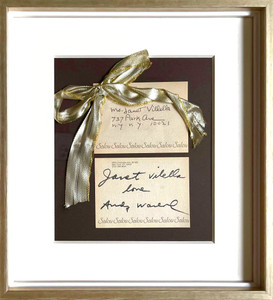
Christopher Makos, Andy Warhol Portrait of Andy Warhol (Hand signed by BOTH Andy Warhol and Christopher Makos), 1986
Various ArtistsCONTACT GALLERY FOR PRICE
Christopher Makos, Andy Warhol
Portrait of Andy Warhol (Hand signed by BOTH Andy Warhol and Christopher Makos), 1986
Gelatin Silver Print, hand signed and annotated by Andy Warhol, Hand signed by Christopher Makos with studio stamp and copyright
Hand signed and annotated "Xtra" by Andy Warhol; hand signed, dated and stamped by Christopher Makos with copyright
Frame included
A rare proof hand signed by both photographer and subject:
Hand signed and annotated "Xtra" by Andy Warhol on the back; hand signed, dated and stamped by Christopher Makos with this copyright
Measurements:
Frame:
19 x 16.75 x 1.75 inches
Photograph:
12.25 x 10.25 inches
About Christopher Makos:
Christopher Makos was born in Lowell, Massachusetts, grew up in California, and moved to New York after high school. He studied architecture in Paris and briefly worked as an apprentice to Man Ray. Andy Warhol, Makos' good friend and frequent portrait subject, called Makos "the most modern photographer in America." His photographs have been exhibited in galleries and museums such as the Guggenheim Museum in Bilbao, the Tate Modern in London, the Whitney Museum of American Art in New York, the IVAM in Valencia (Spain) and the Reina Sofia Museum in Madrid. His pictures have appeared in magazines and newspapers, including Paris Match and Wall Street Journal. He is the author of several important books, like the volumes Warhol/Makos In Context (2007), Andy Warhol China 1982 (2007) and Christopher Makos Polaroids (2009).
Courtesy of Makostudio
About Andy Warhol:
Isn’t life a series of images that change as they repeat themselves?
—Andy Warhol
Andy Warhol’s (1928–1987) art encapsulates the 1960s through the 1980s in New York. By imitating the familiar aesthetics of mass media, advertising, and celebrity culture, Warhol blurred the boundaries between his work and the world that inspired it, producing images that have become as pervasive as their sources.
Warhol grew up in a working-class suburb of Pittsburgh. His parents were Slovak immigrants, and he was the only member of his family to attend college. He entered the Carnegie Institute of Technology (now Carnegie Mellon University) in 1945, where he majored in pictorial design. After graduation, he moved to New York with fellow student Philip Pearlstein and found steady work as a commercial illustrator at several magazines, including Vogue, Harper’s Bazaar, and the New Yorker. Throughout the 1950s Warhol enjoyed a successful career as a commercial artist, winning several commendations from the Art Directors Club and the American Institute of Graphic Arts. He had his first solo exhibition at the Hugo Gallery in 1952, showing drawings based on the writings of Truman Capote; three years later his work was included in a group show at the Museum of Modern Art for the first time.
The year 1960 marked a turning point in Warhol’s prolific career. He painted his first works based on comics and advertisements, enlarging and transferring the source images onto canvas using a projector. In 1961 Warhol showed these hand-painted works, including Little King (1961) and Saturday’s Popeye (1961), in a window display at the department store Bonwit Teller; in 1962 he painted his famous Campbell’s Soup Cans, thirty-two separate canvases, each depicting a canned soup of a different flavor. Soon after, Warhol began to borrow not only the subject matter of printed media, but the technology as well. Incorporating the silkscreen technique, he created grids of stamps, Coca-Cola bottles, shipping and handling labels, dollar bills, coffee labels, and more, breaking down the images to their basic graphic components.
In 1963 Warhol established a studio on East 47th Street, which became known as the Factory and served as a cultural hub for artists, models, performers, and socialites. His inner circle comprised his Superstars, who played a major role in both his work and his social life. Interested in the production of fame, Warhol began to screen-print images of celebrities and public figures, from Marilyn Monroe and Elvis Presley to Jackie Kennedy and Mao Zedong. Expanding his practice, as well as his cultural influence, he produced records (The Velvet Underground & Nico), started a magazine (Interview), and made avant-garde films, such as Chelsea Girls (1966), Blow Job (1964), and Empire (1964), which have become classics of the underground genre.
Following a close run-in with death when Valerie Solanas shot him in 1968, Warhol entered a more subdued, isolated period, working primarily on a commissioned basis and painting portraits for various patrons, while also revisiting themes from his earlier work. He then began to pursue a new interest in abstraction, first with his Oxidations (1977–78), made by allowing friends and acquaintances to urinate on canvases painted with metallic pigments, and later with his Rorschach (1984) and Camouflage (1986) paintings.
By the early 1980s Warhol was producing work across media with a renewed vigor, hosting half-hour programs on MTV, publishing books, and collaborating with younger artists including Jean-Michel Basquiat, Francesco Clemente, and Keith Haring. His abstract series coincided with large-scale works that looked back at masterpieces by Leonardo da Vinci: he screen-printed images of the Mona Lisa (1503) and created several monumental canvases of The Last Supper (1495–98). Warhol’s ability to seamlessly combine art historical reference, abstract patterns, and mass media set new standards for the role of the artist, permanently blurring the lines between commercial and fine art.
Courtesy of Gagosian Gallery















